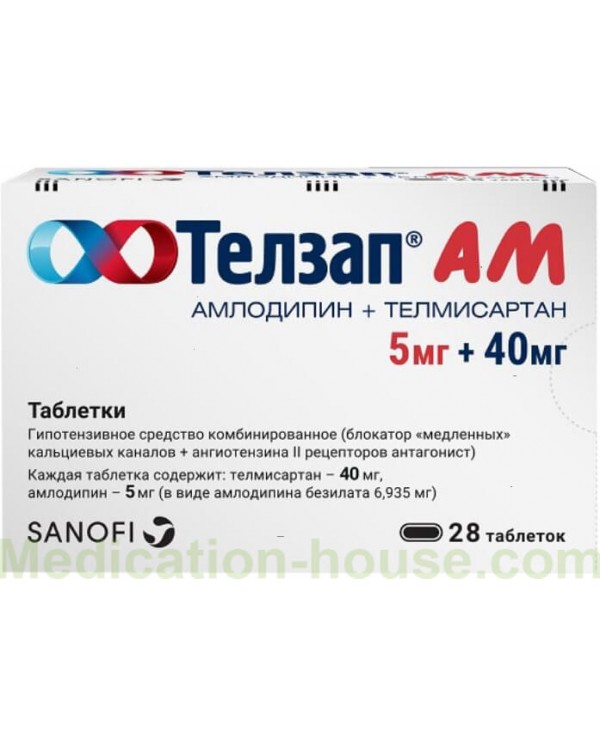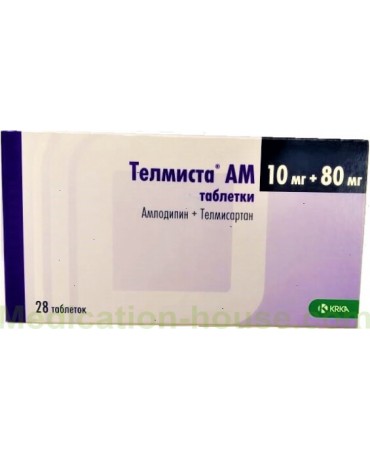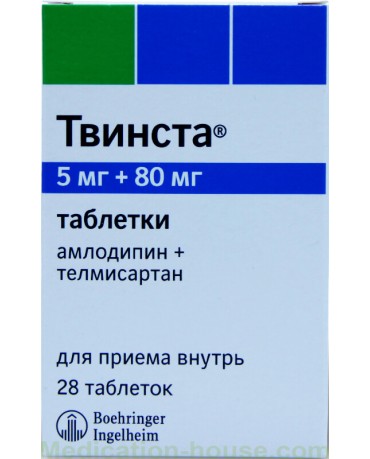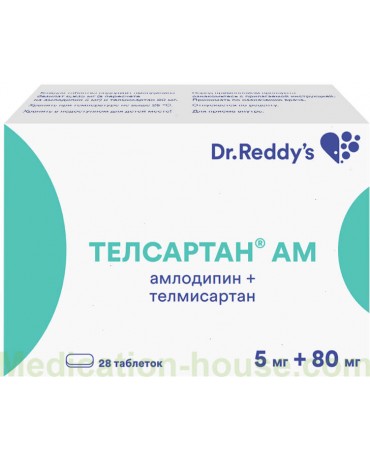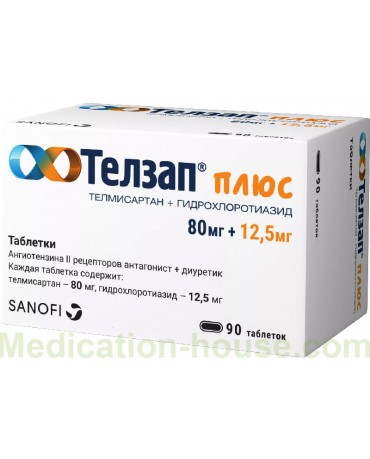User manual for Telzap AM
Reed more and buy Telzap AM here
Telzap AM is an antihypertensive drug.
Release form and composition
The drug is produced in the form of tablets: oblong, biconvex, from almost white or white to yellowish or yellow, engraved on one side of tablets with a dosage of 5 mg + 40 mg - "5" and "40" and risk, 5 mg + 80 mg - "5" and "80" and risk (risks are not intended for breaking), 10 mg + 40 mg - "10" and "40", 10 mg + 80 mg - "10" and "80" (7, 10 or 14 pcs. In blisters, in a cardboard box 1, 2, 3, 4, 7, 8 or 9 blisters and instructions for the use of Telzap AM).
Depending on the dosage, the content of active ingredients in 1 tablet of Telzap AM is:
5 mg + 40 mg: amlodipine besylate - 6.935 mg (amlodipine - 5 mg) + telmisartan - 40 mg;
5 mg + 80 mg: amlodipine besylate - 6.935 mg (amlodipine - 5 mg) + telmisartan - 80 mg;
10 mg + 40 mg: amlodipine besylate - 13.87 mg (amlodipine - 10 mg) + telmisartan - 40 mg;
10 mg + 80 mg: amlodipine besylate - 13.87 mg (amlodipine - 10 mg) + telmisartan - 80 mg.
Auxiliary components: microcrystalline cellulose, sorbitol, povidone K25, sodium hydroxide, meglumine, calcium hydrogen phosphate dihydrate, magnesium stearate.
Pharmacodynamics
Telzap AM is a combined antihypertensive drug for patients with essential arterial hypertension. Contains two active substances: amlodipine [slow calcium channel blocker (BMCC)] and telmisartan [angiotensin II receptor antagonist (ARA II)], the complementary action of which provides more effective control of blood pressure (blood pressure).
The mechanism of action of Telzap AM is due to the following properties of the active ingredients:
amlodipine: is a dihydropyridine derivative that inhibits the transmembrane entry of calcium ions into cardiomyocytes and smooth muscle cells of blood vessels. It has a vasodilating effect on vascular smooth muscle. Reduces myocardial ischemia, firstly, due to the property of expanding peripheral arterioles, which leads to a decrease in OPSS (total peripheral vascular resistance) or afterload; almost does not increase heart rate (heart rate), while the load on the heart muscle decreases, energy consumption and myocardial oxygen demand decrease. Secondly, the property of amlodipine to expand the main coronary arteries and arterioles in ischemic zones and zones of the myocardium with normal blood flow, helps to increase the delivery of oxygen to the myocardium in spasm of the coronary arteries (including Prinzmetal's angina). In case of arterial hypertension, a clinically significant decrease in blood pressure in the supine and standing position for 24 hours is ensured by taking Telzap AM once a day. Orthostatic arterial hypotension is not typical for amlodipine therapy. With normal renal function, therapeutic doses of the drug lead to a decrease in renal vascular resistance, an increase in GFR (glomerular filtration rate) and effective plasma blood flow in the kidneys without disrupting filtration or developing proteinuria. It does not cause any metabolic side effects or changes in plasma lipids. Amlodipine is indicated for use in bronchial asthma, diabetes mellitus and gout. In patients with heart failure, left ventricular ejection fraction and exercise tolerance are not reduced;
Telmisartan: specific ARA II, has a very high affinity for the binding site of the AT1 subtype receptor with angiotensin II, which makes it possible to displace the latter from this bond without acting as an agonist against this receptor. Not showing the properties of a partial agonist of the AT1 receptor, it binds selectively and for a long time to it. Telmisartan has no affinity for other receptors. Reduces the level of aldosterone in the blood plasma, does not block ion channels, does not inhibit renin, does not inhibit the activity of ACE (angiotensin-converting enzyme) kininase II, which destroys bradykinin. After receiving the first dose, the hypotensive effect develops within 3 hours, a pronounced effect is usually achieved after 28 days of regular intake. Almost complete relief of an increase in blood pressure is observed when the substance is used in a daily dose of 80 mg, the effect lasts for 24 hours and remains significant for 48 hours. Without affecting heart rate, it provides a decrease in systolic / diastolic blood pressure. Abrupt withdrawal of the drug does not cause withdrawal symptoms. With the use of telmisartan, the development of dry cough is much less common, compared with therapy with ACE inhibitors.
The combined composition of Telzap AM promotes an effective and sustained lowering of blood pressure within 24 hours with a single dosage regimen.
Pharmacokinetics
After oral administration in a therapeutic dose, the maximum concentration (Cmax) of amlodipine in the blood plasma is reached after 6-12 hours. Telmisartan is rapidly absorbed, but the degree of absorption may vary. Absolute bioavailability: amlodipine - 64-80%, telmisartan - on average 50%. Food does not have a clinically significant effect on the bioavailability of active substances Telzap AM.
Plasma protein binding: amlodipine ~ 97.5%, telmisartan (mainly with albumin and alpha-1-acid glycoproteins)> 99.5%. Apparent volume of distribution: amlodipine - 21 l / kg, telmisartan ~ 500 l.
Metabolism of amlodipine to a large extent (about 90%) occurs in the liver with the formation of inactive metabolites. Biotransformation of telmisartan consists in its conjugation with glucuronic acid, with the formation of a pharmacologically inactive conjugate.
Half-life (T1 / 2): amlodipine - 35-50 hours, telmisartan - more than 20 hours. Amlodipine is excreted in two phases from blood plasma. Excretion of active substances Telzap AM: amlodipine - through the kidneys (60% in the form of metabolites, 10% - unchanged), telmisartan - through the intestine unchanged.
The total plasma clearance of telmisartan is about 1000 ml / min, hepatic blood flow is about 1500 ml / min.
With hepatic insufficiency, a decrease in the clearance of amlodipine, an increase in T1 / 2 and an increase in AUC (area under the concentration-time curve) by about 40-60% is possible. The absolute bioavailability of telmisartan increases to almost 100%.
In elderly patients, the period of reaching Cmax of amlodipine in blood plasma does not change, the clearance rate decreases, and AUC and T1 / 2 increase.
In women, the Cmax of telmisartan is approximately 3 times, and the AUC is 2 times higher than in men.
In case of impaired renal function of any severity, an increase in the level of telmisartan in the blood plasma is observed by 2 times, T1 / 2 does not change.
During hemodialysis, telmisartan is not excreted from the body.
Indications for use
The use of Telzap AM is indicated for arterial hypertension in the following cases:
previous treatment with separate dosage forms of amlodipine and telmisartan - to replace this therapy;
insufficient blood pressure control with monotherapy with amlodipine or telmisartan;
the appointment of Telzap AM to patients who are shown a combined intake of amlodipine and telmisartan.
Contraindications
Absolute:
severe arterial hypotension;
hemodynamically unstable heart failure after acute myocardial infarction;
obstruction of the outflow tract of the left ventricle (including a high risk of developing aortic stenosis);
obstructive pathology of the biliary tract;
severe liver dysfunction;
shock (including cardiogenic);
concomitant therapy with aliskiren or drugs containing aliskiren in patients with diabetes mellitus and / or with moderate or severe renal impairment (GFR less than 60 ml / min / 1.73 m2);
combination with ACE inhibitors for diabetic nephropathy;
deficiency of sucrase and isomaltase, fructose intolerance, glucose-galactose malabsorption syndrome;
period of pregnancy;
breast-feeding;
age under 18;
hypersensitivity to dihydropyridine derivatives or drug components.
Telzap AM tablets should be used with caution in case of unstable angina pectoris, acute myocardial infarction and within one month after myocardial infarction, stenosis of the aortic or mitral valve, coronary heart disease, severe bradycardia and tachycardia, CHF (chronic heart failure) of non-ischemic etiology III – IV functional NYHA (New York Heart Association) class, hypertrophic obstructive cardiomyopathy, clinically significant cerebral atherosclerosis, impaired liver and / or kidney function, bilateral renal artery stenosis or artery stenosis of a single functioning kidney, condition after kidney transplantation, diabetes mellitus, primary hyperaldosteronism, hyponatremia, hyperkalemia; with a decrease in the BCC (circulating blood volume) caused by previous intake of diuretics, restriction of salt intake, diarrhea or vomiting, as well as persons over the age of 65.
Telzap AM, instructions for use: method and dosage
Telzap AM tablets are taken orally with a small amount of liquid, once a day, regardless of the diet.
Patients who use amlodipine in combination with telmisartan in the form of separate tablets are prescribed Telzap AM, containing the same doses of active ingredients.
Prescribing the drug is indicated if taking only one amlodipine or telmisartan does not provide adequate control of blood pressure.
Recommended dosage: initial dose - Telzap AM tablets 5 mg + 40 mg or 5 mg + 80 mg, if necessary, a more significant decrease in blood pressure. 14 days after the start of therapy, a gradual increase in dose is shown to further reduce blood pressure. The maximum daily dose is 10 mg + 80 mg.
If, against the background of monotherapy with amlodipine at a dose of 10 mg, peripheral edema and other adverse reactions occur, it is advisable to reduce the dose of amlodipine. In this case, the transition to Telzap AM 5 mg + 40 mg ensures the preservation of the expected hypotensive effect.
Side effects
Adverse reactions registered with monotherapy with amlodipine or telmisartan, and with their combination, which can potentially occur during treatment with Telzap AM:
infections and invasions: cystitis and other urinary tract infections, pharyngitis, sinusitis and other upper respiratory tract infections, sepsis (including fatal);
mental disorders: insomnia, anxiety, anxiety and other mood changes, depression, confusion;
immune system: hypersensitivity reactions, anaphylaxis;
hematopoietic system: thrombocytopenia, leukopenia, anemia, eosinophilia;
nervous system: drowsiness, headache, migraine, dizziness, tremor, hypesthesia, paresthesia, dysgeusia, syncope, peripheral neuropathy, hypertonicity, fainting, extrapyramidal disorders;
cardiovascular system: lowering blood pressure, palpitations and / or rush of blood to the skin, arrhythmia (bradycardia, ventricular tachycardia and atrial fibrillation), orthostatic hypotension, tachycardia, vasculitis, myocardial infarction;
respiratory system: shortness of breath, rhinitis, cough, interstitial lung disease;
digestive system: abdominal pain, dryness of the oral mucosa, nausea, bloating, diarrhea, constipation and other interruptions in the rhythm of bowel movements, dyspepsia, vomiting, gingival hyperplasia, stomach discomfort, gastritis, pancreatitis, liver dysfunction or damage, jaundice , hepatitis;
organ of vision: diplopia and other visual disorders;
hearing organ and labyrinthine disorders: tinnitus, vertigo;
musculoskeletal system: muscle spasms, back pain, arthralgia, myalgia, pain in the limbs and / or tendons;
skin and subcutaneous tissues: swelling of the ankles and feet, purpura, the appearance of discolored areas of the skin, alopecia, itching, rash, increased sweating, urticaria, exanthema, angioedema (possibly fatal), eczema, erythema, drug rash, toxicolyoderma, excreta , erythema multiforme, Stevens-Johnson syndrome, toxic epidermal necrolysis, photosensitivity;
urinary system: frequent urination, nocturia, dysuria, impaired renal function, acute renal failure;
genitals and mammary gland: gynecomastia, erectile dysfunction;
metabolism: decrease or increase in body weight, hyperglycemia, hyperkalemia, with diabetes mellitus - hypoglycemia;
laboratory parameters: an increase in the level of creatinine and / or uric acid in the blood plasma, a decrease in the hemoglobin content in the blood plasma, an increase in the concentration of creatine phosphokinase in the blood plasma and the activity of hepatic enzymes;
others: general malaise, swelling, fatigue, chest pain, asthenic syndrome, pain, flu-like syndrome.
Overdose
Symptoms of an overdose of Telzap AM: a pronounced and persistent decrease in blood pressure (including shock and death), dizziness, significant peripheral vasodilation, reflex tachycardia, bradycardia, acute renal failure, an increase in plasma creatinine concentration.
Treatment: immediate gastric lavage and / or stimulation of vomiting, intake of activated charcoal. After that, the patient should lie on his back with raised legs. If necessary, symptomatic and supportive therapy is used. The patient is provided with close observation, control of the concentration of electrolytes and creatinine in the blood plasma. To replenish the BCC, the immediate introduction of plasma-substituting solutions is recommended; to restore vascular tone and normalize blood pressure, vasoconstrictors are prescribed (if the patient has no contraindications to them). In order to relieve symptoms associated with calcium channel blockade, intravenous administration of calcium gluconate is indicated.
The use of hemodialysis is ineffective.
Special instructions
Before using Telzap AM, it is necessary to determine the BCC and sodium content in the blood plasma, if necessary, their deficiency is eliminated.
It should be borne in mind that telmisartan may contribute to the development of hyperkalemia. In renal failure, diabetes mellitus, in patients with concomitant pathological conditions, the elderly or at the same time taking other drugs that increase the potassium content in the blood plasma, hyperkalemia can cause death. Therefore, this category of patients must carefully monitor the content of potassium in the blood plasma when receiving antihypertensive therapy.
Influence on the ability to drive vehicles and complex mechanisms
During the period of Telzap AM use, it is recommended to be careful when performing all activities that require concentration of attention and high speed of psychomotor reactions, including driving.
Application during pregnancy and lactation
The use of Telzap AM is contraindicated during pregnancy and breastfeeding.
Childhood use
The use of Telzap AM is contraindicated in patients under 18 years of age.
With impaired renal function
Telzap AM is used with caution in severe renal impairment, condition after kidney transplantation, bilateral renal artery stenosis or artery stenosis of a single functioning kidney, as well as in patients on hemodialysis.
No dose adjustment is required for mild or moderate renal impairment.
For violations of liver function
The use of Telzap AM is contraindicated in severe liver dysfunction.
Telzap AM is used with caution in case of mild or moderate liver dysfunction, the daily dose of telmisartan for this category of patients should not exceed 40 mg.
Use in the elderly
Telzap AM is used with caution in elderly patients over the age of 65 years. No dose adjustment is required.
Drug interactions
powerful and moderate inhibitors of the CYP3A4 isoenzyme (combination of Telzap AM with HIV protease inhibitors, antifungal agents of the azole group, verapamil, diltiazem, erythromycin, clarithromycin or other macrolides): may increase the risk of a sharp decrease in blood pressure, especially in elderly patients;
inducers of the CYP3A4 isoenzyme (rifampicin, St. John's wort preparations): affect the concentration of amlodipine, its dose may need to be adjusted;
grapefruit: eating grapefruit juice or grapefruit may enhance the antihypertensive effect of amlodipine;
dantrolene (for infusion): increases the risk of developing hyperkalemia;
other antihypertensive drugs: there is an increase in the action of each of the drugs;
atorvastatin, warfarin: the pharmacokinetics of these drugs does not change;
cyclosporine: the concentration of cyclosporine may increase significantly;
simvastatin: the systemic exposure of simvastatin increases, so its daily dose should be no more than 20 mg;
tacrolimus: there is a risk of increased plasma levels and toxic effects of tacrolimus, dose adjustment may be required;
beta-blockers, long-acting nitrates, nitroglycerin for sublingual administration, antibiotics, sildenafil: therapy with these agents does not cause danger;
digoxin: the concentration of digoxin in the body is increasing, all measures should be taken to maintain it within the therapeutic range;
eplerenone, spironolactone, triamterene, amiloride, potassium-containing dietary supplements, other potassium-sparing diuretics, potassium-containing salt substitutes or dietary supplements: taking them simultaneously with telmisartan significantly increases plasma potassium;
lithium preparations: it is not recommended to prescribe lithium preparations due to a possible reversible increase in the level of lithium in the blood plasma, accompanied by symptoms of toxicity;
non-steroidal anti-inflammatory drugs (NSAIDs) (salicylic acid in an anti-inflammatory dose, cyclooxygenase-2 inhibitors, non-selective NSAIDs): when taken simultaneously with Telzap AM, they cause a weakening of the antihypertensive effect of telmisartan;
thiazide and loop diuretics: against the background of previous therapy with high doses of diuretics, the risk of a significant decrease in blood pressure increases;
aliskiren, ACE inhibitors: the combination of these agents causes a double blockade of the RAAS (renin-angiotensin-aldosterone system), accompanied by a sharp decrease in blood pressure, impaired renal function (up to acute renal failure) and hyperkalemia;
glucocorticoids of systemic action: contribute to the weakening of the activity of telmisartan;
insulin, oral hypoglycemic agents: the combination of telmisartan with these agents can cause hypoglycemia, therefore, treatment should be accompanied by careful monitoring of blood glucose levels;
drugs, antidepressants, ethanol, barbiturates: each of these drugs increases the risk of developing orthostatic hypotension.
Terms and conditions of storage
Keep out of the reach of children.
Store at temperatures up to 25 ° C.
Shelf life is 2 years.
Reviews
The few reviews about Telzap AM are positive. Some patients, along with effective pressure reduction, especially note the absence of any adverse reactions.
Terms of sell
You don't need a prescription to buy Telzap AM.

